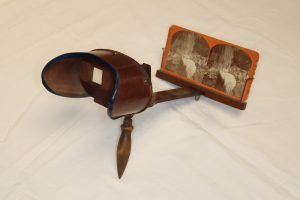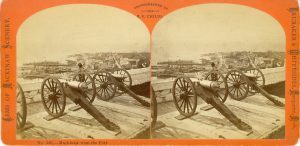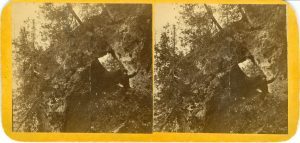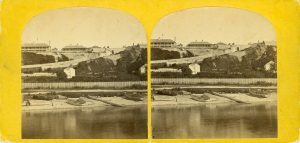In 1838, Sir Charles Wheatstone, an English scientist and inventor, discovered an interesting way to take a 2-dimensional picture and make it appear 3-dimensional. By taking two images of the same thing from slightly different angles and then viewing them from one eye each, the brain creates a 3-D image of what is in front of it. This is, after all, how human eyesight works. Each eye sees the world from a slightly different perspective, which allows the brain to view the entire world three dimensionally. Wheatstone used this discovery to create a large device to simulate this, which was the world’s first stereoscope.


Years later, Scottish scientist David Brewster took the design and crafted a handheld version of it. Many other inventors, such as Oliver Wendell Holmes created even simpler versions as well. These handheld stereoscopes work by taking a card with two nearly identical images called a stereoview (or stereograph) and placing them into grooves or bars at the end of the device. At the other end there is a set of lenses that eyes look into, almost like binoculars. These lenses direct eyes to the images at different angles, creating the 3-D effect that Wheatstone discovered.


Handheld stereoscopes became extremely popular, as both the stereoscopes and stereoviews could be produced for little cost, meaning that they were affordable. Another reason for their mass popularity was the recent invention of daguerreotype photography, which meant that stereoscopes could view not only illustrations, but actual pictures of interesting places from around world. From the comfort of your parlor you could be transported to Venice, the Great Wall of China, the Yosemite Valley, and, of course, Mackinac Island!


Hundreds of images of iconic spots on Mackinac Island were produced as stereoviews, allowing people from all over the world to view the most alluring spots on the most magnificent island in Michigan. Mackinac State Historic Parks has many of these stereoviews in their collection. These include images of Arch Rock, Sugar Loaf, Robinson’s Folly, Fort Mackinac, Mission Church, Skull Cave, and many more iconic locations. These allow us to see Mackinac the way people did over 100 years ago. Some Mackinac stereoviews are of locations that don’t even exist anymore. For example, the collection preserves stereoviews of Fairy Arch, a unique geological formation that was destroyed in the creation of State Highway M-185. Not only do stereoviews and stereoscopes allow us to see these historic photos of Mackinac Island, but they also allow us to see them in 3-D.


If you are interested in seeing stereoscopes and stereoviews at Mackinac State Historic Parks, there are many locations you can visit. A stereoscope and a stack of stereoviews can be seen on a table in the parlor exhibit at Old Mackinac Point Lighthouse as well as the east parlor of the Officers Hill Quarters at Fort Mackinac. Stereoscopes that can be used by visitors to look at stereoviews are found in the Office exhibit and Soldier’s Barracks in Fort Mackinac and at the new Milliken Nature Center at Arch Rock.
A majority of the stereoviews in MSHP’s collection are not on public display. Images and reproductions are often used in exhibits because prolonged exposure can heavily damage originals. However, if you are interested in conducting research on original stereoviews, appointments can be made for a visit to the Keith Widder Library at the Petersen Center in Mackinaw City. Please contact Brian Jaeschke, Curator of Collections at Mackinac State Historic Parks. He can be reached by calling 231-436-4100 or emailing jaeschkeb@michigan.gov.








